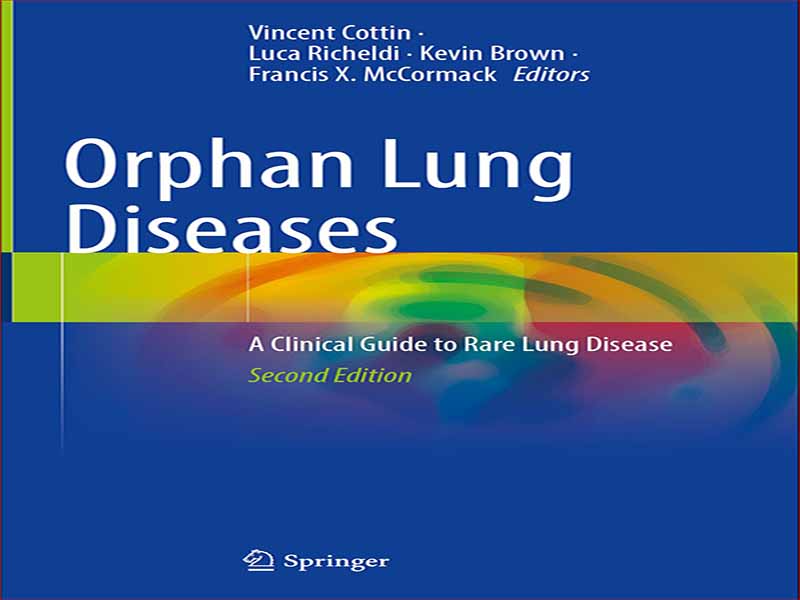- عنوان کتاب: Microbiome in Inflammatory Lung Diseases
- نویسنده: Vincent Cottin
- حوزه: بیماریهای تنفسی
- سال انتشار: 2023
- تعداد صفحه: 789
- زبان اصلی: انگلیسی
- نوع فایل: pdf
- حجم فایل: 29.0 مگابایت
بیماریهای به اصطلاح یتیم، شرایطی هستند که توجه کمی توسط پزشکان و دانشمندان را به خود جلب میکنند، که تحقیقات گستردهای در مورد آنها انجام نشده و درمانهای خاصی وجود ندارد. بیماری های یتیم با این وجود با نیازها و انتظارات بالا از بیماران مشخص می شوند، بیمارانی که احساس می کنند در دنیای مراقبت های بهداشتی رها شده اند و از پزشک معالج خود انتظار دارند تا با مدیریت بهترین بیماری به آنها کمک کند. با این حال، از آنجایی که نمی توان انتظار داشت که پزشکان در مورد هر یک از 6000 تا 8000 بیماری یتیم آگاه باشند، آنها معمولاً تجربه بسیاری از بیماری های یتیم را ندارند و دانش کافی برای مدیریت این بیماران ندارند. در واقع، بیشتر بیماری های یتیم حداقل در اروپا و آمریکای شمالی نادر هستند. با این حال، همه بیماریهای یتیم نادر نیستند، و بهویژه بیماریهای عفونی استوایی نادیده گرفته شده در آفریقا، آسیا و قاره آمریکا بومی هستند و یک میلیارد نفر را در سراسر جهان تحت تأثیر قرار میدهند و باعث مرگ و میر و عوارض شدید میشوند. بیماری های نادر به صورت عددی تعریف می شوند. در اروپا، اگر در سال 2000 کمتر از 1 نفر را مبتلا کرده باشد، یک بیماری نادر است. در ایالات متحده، بیماری نادر بیماری است که کمتر از 200000 نفر را مبتلا کرده یا بیش از 200000 نفر را تحت تاثیر قرار می دهد، اما هیچ انتظار منطقی از نظر اقتصادی وجود ندارد. سودآور، با هزینه توسعه دارو و در دسترس بودن چنین بیماری از فروش بهبود می یابد. به طور کلی، با توجه به انبوهی از شرایط مختلف، بیماری های نادر یک بار عمده مراقبت های بهداشتی در سراسر جهان هستند. تنها در مورد پزشکی ریه، تخمین زده می شود که 1.5-3 میلیون اروپایی و 1.2-2.5 میلیون آمریکایی به یک بیماری نادر ریه مبتلا هستند. علیرغم مشکلات و موانع فراوان، هزاره جدید شاهد پیشرفت شگفتانگیزی در شتاب بهبود درک ما و مدیریت بسیاری از بیماریهای نادر بود که برخی از آنها دیگر یتیم نیستند. علاقه به بیماری های نادر در سراسر جهان به شدت افزایش یافته است. بیماران مبتلا به بیماریهای یتیم به انجمنهایی ملحق شدهاند که حس ناشناختهای از جامعه، آگاهی بیسابقه و حمایت قوی برای تحقیقات بیشتر و درمانهای بهتر را به آنها ارائه میدهند. تعداد سازمانها و وبسایتهای بینالمللی به طور پیوسته در حال افزایش به آموزش، پشتیبانی و تحقیقات کمک میکنند. دولتها و سازمانها مشوقهایی را برای تشویق صنعت داروسازی به سرمایهگذاری در تحقیقات علیرغم جمعیتهای هدف کوچک ارائه کردهاند. مراکز تخصصی و شبکههای بالینی اکنون در حال توسعه هستند و در بسیاری از کشورها شناسایی شدهاند: این مرحله حیاتی مدیریت بهروز را برای بیماران فراهم میکند، امکان تحقیقات پایه و بالینی را فراهم میکند، ثبتها را ایجاد میکند، با آژانسهای نظارتی تعامل دارد، و از انجمنهای بیماران حمایت میکند. شرایط و سندرم های جدیدی کشف می شوند. عوامل ژنتیکی بسیاری از بیماری ها و پاتوفیزیولوژی زمینه ای آنها به تدریج بهتر شناخته می شوند. تعداد فزاینده ای از کاندیداهای دارو شناسایی می شوند و ممکن است با تکمیل کارآزمایی های بالینی بیشتر به آنها یک داروی یتیم اعطا شود که در نتیجه منجر به تایید و مجوز داروها در بیماری هایی می شود که تاکنون غیر قابل درمان تلقی می شدند. بیماری هایی مانند فشار خون شریانی ریوی و فیبروز ریوی ایدیوپاتیک، که قبلاً فاقد هرگونه درمانی بودند، اکنون قابل درمان هستند، اگرچه هنوز کشنده و شدید هستند و قابل درمان نیستند. در این زمینه، تشخیص و مدیریت بیماران مبتلا به بیماریهای ریوی یتیم یک چالش فزاینده برای متخصصان ریه و متخصصان داخلی است، زیرا بهطور فزایندهای دشوار است که با سرعت فعلی رشد دانش، بهویژه در علوم پایه، همگام شوند. مشاهده تکامل این رشته بسیار محرک است زیرا پیشرفت در پاتوفیزیولوژی، سازماندهی مراقبت و مدیریت به سرعت به عملکرد بالینی برای نفع و بهبود بیماران تبدیل می شود. با ادامه پیشرفت، مطمئناً ابزارهای تشخیصی و گزینه های درمانی اضافی به زودی در دسترس خواهند بود. ما به عنوان پزشک نباید اجازه دهیم بیمارانمان هیچ فرصتی را برای تشخیص صحیح (پرهیز از اقدامات غیر ضروری) و بهترین مدیریت از دست بدهند. هدف ما در این کتاب ارائه اطلاعات ترکیبی و آسان در مورد بیماری های اصلی ریه یتیم است. اگرچه برخی از ادبیات از طریق مقالات اصلی و مقالات مروری در دسترس است، اغلب یافتن پاسخ به موقع به سؤالاتی که پزشکان مراقبت از بیماران با آن مواجه هستند دشوار است. آنها در اینجا اطلاعاتی را خواهند یافت که به سمت عمل بالینی، به ویژه رویکرد تشخیصی (شامل تظاهراتی که بیماری، روشهای تأیید تشخیصی، معیارهای تشخیصی و تشخیص افتراقی را نشان میدهد) پیدا میکنند. خواننده متوجه خواهد شد که اگرچه جامع و شامل اکثر بیماری های نادر و یتیم ریوی است، این کتاب درسی در تلاش برای معقول نگه داشتن اندازه آن کاملاً جامع نیست.
So-called orphan diseases are those conditions that attract little interest by physicians and scientists, which are not widely researched, and where specific treatments are lacking. Orphan diseases are nevertheless characterized by particularly high needs and expectations from patients, who feel abandoned in the world of health care and expect their treating physician to make every possible effort to help them by managing at best their disease. However, as one cannot expect physicians to be knowledgeable with each of the 6000–8000 orphan diseases, they generally lack experience of most orphan diseases and are left with insufficient knowledge to manage these patients. Indeed, most orphan diseases are rare, at least in Europe and North America. Not all orphan diseases are rare, however, and especially neglected tropical infectious diseases are endemic in Africa, Asia, and the Americas, affecting one billion people worldwide and causing tremendous morbidity and mortality. Rare diseases are defined numerically. In Europe, a disease is rare if it affects fewer than 1 person in 2000. In the USA, a rare disease is a disease that affects fewer than 200,000 people or that affects more than 200,000 but for which there is no reasonable expectation to be economically profitable, with the cost of drug development and availability for such a disease to be recovered from sales. Overall, given the plethora of different conditions, rare diseases are a major health-care burden worldwide. Regarding lung medicine alone, it is estimated that 1.5–3 million Europeans and 1.2–2.5 million Americans are affected by a rare lung disease. Despite the many difficulties and obstacles, the new millennium witnessed an astonishing gain in the momentum to improve our understanding and the management of many rare diseases, some of which are, therefore, no longer orphan. Interest in rare diseases has increased greatly worldwide. Patients with orphan diseases have joined associations providing them with a previously unknown sense of community, unprecedented awareness, and strong advocacy for more research and better treatments. A steadily increasing number of international organizations and websites contribute to education, support, and research. Governments and agencies have introduced incentives to encourage the pharmaceutical industry to invest in research despite the small target populations. Specialized centers and clinical networks are now developing and have been identified in many countries: This crucial step provides up-to-date management to patients, allows basic and clinical research, establishes registries, interacts with regulatory agencies, and supports patient associations. Novel conditions and syndromes are discovered. The genetic determinants of many diseases and their underlying pathophysiology are progressively better understood. An increasing number of drug candidates are identified and may be granted an orphan drug designation with more clinical trials completed, thereby leading to the approval and licensing of drugs in diseases heretofore considered not treatable. Diseases such as pulmonary arterial hypertension and idiopathic pulmonary fibrosis, formerly devoid of any treatment, are now treatable although they are still deadly severe and not curable. In this context, diagnosing and managing patients with orphan pulmonary diseases is an increasing challenge to pulmonologists and internal medicine specialists as it is increasingly difficult to keep up to the current pace of growth of knowledge, especially in basic science. To witness the evolution of this field is tremendously stimulating since progress made in pathophysiology, organization of care, and management rapidly translates into clinical practice for the benefit and better-being of patients. As progress continues, it is sure that additional diagnostic instruments and treatment options will soon be available. We, as doctors, should not let our patients miss any opportunity to get the correct diagnosis (avoiding unnecessary procedures) and the best management. Our goal in this book is to provide synthesized and easily accessible information about the main orphan lung diseases. Although some literature is available through original articles and review articles, it is often difficult to find in a timely manner the answers to questions that clinicians caring for patients are facing. They will find here information oriented toward clinical practice, especially the diagnostic approach (including manifestations suggesting the disease, methods for diagnostic confirmation, diagnostic criteria, and differential diagnosis). The reader will understand that although comprehensive and covering most rare and orphan pulmonary diseases, this textbook is not fully exhaustive in an attempt to keep its size reasonable.
این کتاب را میتوانید بصورت رایگان از لینک زیر دانلود نمایید.
Download: Microbiome in Inflammatory Lung Diseases


































نظرات کاربران